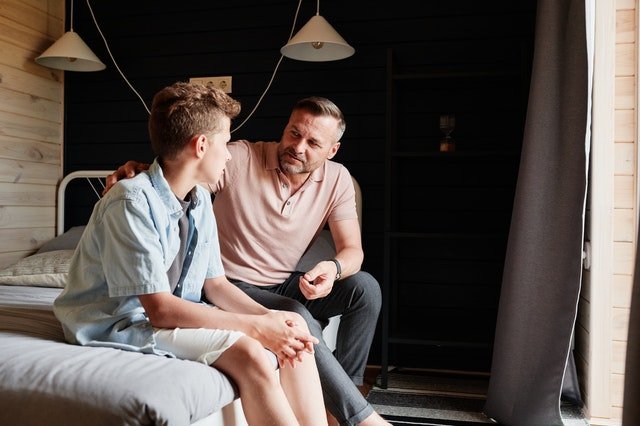Supporting young people’s mental health after an emergency
Our colleague from the UK Trauma Council (UKTC) shares how to reduce the impact of potentially traumatic events.

Facing distressing events in childhood
As much as we would like to - and should try to - we often can’t prevent frightening and distressing things from happening to babies, children and young people.
Some emergencies and catastrophes follow natural disasters or are the unintended consequence of poor decisions. Sometimes truly awful things happen to children following the deliberate actions of others. We see this around the world and closer to home as children are embroiled in wars, wildfires threaten communities, gunfire and knife crime occurs in schools and on the streets, while in homes poverty, addiction and abuse create emergencies of their own.
In the aftermath, we are left wondering what we can do to protect children from enduring mental health difficulties. Our fear of doing the wrong thing or of making things worse can undermine our confidence in responding.
Our new resource
On Friday (10 October) it’s World Mental Health Day which, this year, highlights the critical need for accessible mental health support during crises and disasters. Ahead of this, the UK Trauma Council (UKTC) is publishing a new resource offering responses to frequently asked questions adults might have about how best to support a child following a potentially traumatic event.
Written in consultation with experts and shaped by parents and young people from the Grenfell Health and Wellbeing Service, who have lived through an incredibly traumatic event, we hope it is a useful tool for when support is needed more than ever.
It unpacks concerns about how a child might react to an event, how to best support them and what to do if we are still worried. The role of social media for young people following traumatic events is also highlighted and it considers if, when and how to talk about what has happened.

What is the UKTC?
The UKTC – an Anna Freud project – is a group of leading experts that bring together expertise in research, practice, policy and lived experience in the field of childhood trauma. We create evidence-based resources to improve professionals and carers’ understanding of the nature and impact of trauma, with the aim of better equipping those who support children and young people exposed to trauma.
In the UKTC, we often describe distressing events as ‘potentially’ traumatic. The word potential is so important, as what is catastrophic to one child or young person, might not be to another.
While we cannot precisely predict which children may experience enduring difficulties with their mental health, we need to be proactive, giving children the potential for growth and healing after an emergency.
How adults can help after potentially traumatic events
Although situations can feel overwhelming, research by Holbfoll et al. offers five key principles that can help shape our response. These principles focus on what helps children feel safe, calm, connected, in control and hopeful. Conversations with parents and young people from the Grenfell Health and Wellbeing Service help us work out what this looks like in practice through the eyes of those with lived experience.
Safety
We can start by thinking about what and who would help this specific child, in this particular situation, feel more safe? We can ask the child directly about who, where and when they feel most safe, carefully considering their culture and needs. Some young people have told us that they like to have a room to feel safe in at school when they are distressed, and may struggle if there isn’t flexibility about when they can access it. Their feelings do not have a schedule.
Calm
We can find out what most helps a child to find their sense of calm in their body and mind by drawing on their interests, strengths and cultural preferences. We might offer them new ideas to soothe - and together try out ways to help them manage any overwhelming feelings of fear and distress. For example, young people have told us about the importance of music to help them feel calmer and manage their mood.
Connection
We can help the child be connected to and feel supported by those who care about them, which can reduce the risk of isolation. Some young people have highlighted the vital role of friendships in helping them cope and how they needed people around them that understood what they were going through.
Control
We can seek to offer the child opportunities to build a sense of control and self-belief to contrast with the inherent lack of control that catastrophic situations bring. Although adults might want to protect and help avoid any further pressure, young people want to be involved and invited to make decisions about their own life, however small.
Hope
Finally, when there is some stability and security, we can think about the possibility of hope. As young people have reminded us, hope for the future is best generated from the young people themselves, rather than forced upon them by adults. So rather than offered as an artificial positivity that clashes with the reality of their circumstances, instead help them to hold on to the possibility of finding a way through. For where there is potential, there is hope.
Further information
Find more practical guidance on supporting children and young people following potentially traumatic events.
With thanks to the User Consultants from the Grenfell Health and Wellbeing Service, who have supported a number of UKTC projects.
About World Mental Health Day
World Mental Health Day is celebrated every year on 10 October to raise awareness of different issues related to mental health. Established by the World Federation for Mental Health, 2025’s theme is ‘access to services - mental health in catastrophes and emergencies’.